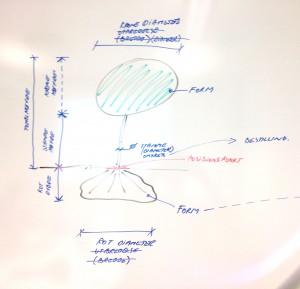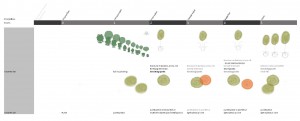
The phases in the linked table are connected to the Statsbygg project model
The tree object
The tree is a digitised version of the physical entity, separated into three parts: Crown, trunk and root system. It is comparable to an electrical mast object, which in return is composed of an armature, mast and foundation part. Each part of the tree object have different sets of properties for geometry and information, used for different purposes in 3D model analysis. The crown yields shadow; both the crown and trunk may obstruct view and access; while the root system may interfere with technical installations below surface.
Modelling
A separate tree is represented with an insertion point that should be defined in the same manner in all modelling tools for the profession, as the point will be referred to by other objects in relation to the tree. This point can define the relationship between the tree itself and the surface composition it is placed into. The height of the tree in relation to the surface should be controlled by the surface elevation, similar to other outdoor objects in the model. A proposal for an insertion point can be center of the crown/trunk in the point where the tree trunk meets the top of its target surface. Notably, in many cases the tree will have a layer of topsoil around it in soft surfaces or vegetation areas, while it will have an immersed area by the trunk covered by a protective frame on hard surfaces. To have a common level of insertion in both these cases, one could agree to have the object insertion point in the center of the tree trunk where it meets the elevation of the adjacent main surface.
A tree should be able to be modelled as a point for singular entity, as a row/avenue or as a defined area when mass planting. This arrangement is done in 2D, while the object elevations are controlled by the target surface.
Geometry trough project stages


This is a really important step forward for BIM for Landscape and I appglaud your efforts. I urge those with a technical interest in BIM to engage with you and help make landscape a part of the IFC in the future.
There needs to be a clear destination between the purpose of 3D for the BIM model and for visualisation in terms of level of detail. For large projects where there may be several hundred or thousand tree and shrub objects, too much graphical detail will impact on the performance of the model as a working tool. However, for the visualisation we need the high detail, often managed through the likes of 3DS Max and touched up in Photoshop. The problem I am encountering most is that many landscape architects want, and expect, the both from the same model. This may be possible in the future as processing power increases and the use of cloud services become ubiquitous but at the moment this is a limiting factor. I don’t have the answer yet but in any argument the importance of LOD and the purpose of the model and data should be quite clearly defined and the current limitations understood.